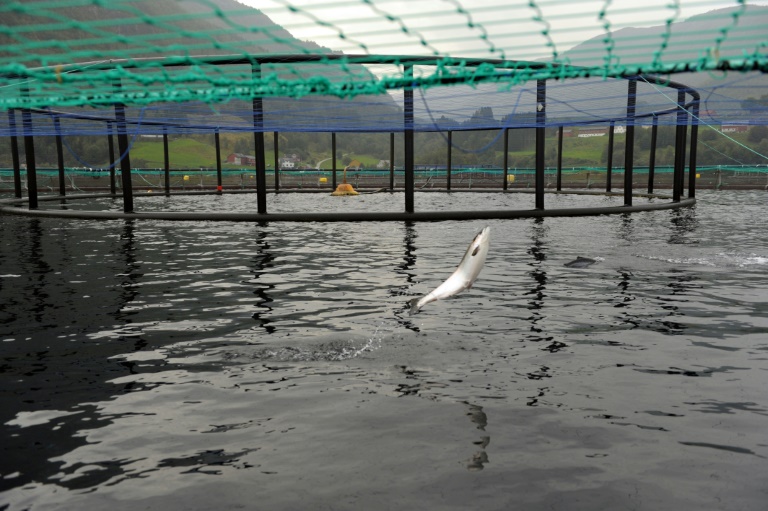"We could produce five times as much fish by 2050": in a posh hotel in the Norwegian town of Trondheim, a fishing industry representative winds up his presentation on Norway's sky-high fish farming goals.
The “potential” for salmon and other farmed fish has been calculated by researchers, Norwegian Seafood Federation spokesman Oyvind Andre Haram tells AFP, noting that each day the Scandinavian country of 5.2 million people produces “14 million meals of salmon.”
Worldwide demand for farmed salmon seems to know no end. Norway, which produces 1.3 million tonnes a year, already accounts for more than half of world production and has no plans to slow down.
The country’s fish farming industry has in the past been taken to task over environmental issues, but it’s determined to resolve those challenges.
“There are two major issues… One is sea lice, and the other is escapes of farmed fish from net pens into the sea,” says Julie Dovle Johansen of conservation group WWF Norway.
Sea lice is a parasite that requires fish farmers to slaughter large amounts of salmon prematurely, costing the industry between 1.0 and 1.5 billion euros ($1.16-$1.75 billion) a year, according to John Arne Breivik, the head of a sea lice removal company.
Sea lice can also spread to wild salmon stocks and kill them.
– Cleaner fish –
Farmed salmon that escape from their cages also risk muddying the gene pool of wild salmon if they mate, according to Dovle Johansen.
Farmed salmon are more fragile to natural threats and have a lower survival rate, a characteristic that can be transmitted to wild salmon, she said.

Farmed salmon are more vulnerable to natural threats than their brethren in the wild
Industry giants are therefore putting a lot of effort into innovative projects to address these problems, raising hopes for the sector — but also concern among environmental activists.
“There’s an ambition by the salmon industry and the (fisheries) ministry to double the production capacity within the next 10-15 years, which we think is quite crazy,” the head of Greenpeace Norway, Truls Gulowsen, told AFP.
In one of the many fjords nestled into the island of Hitra off Norway’s western coast, thousands of farmed salmon teem in the ocean water in circular pens belonging to the Leroy fishing group, dancing and gliding in a never-ending water ballet.
Leroy is the world’s second biggest salmon producer.
Lena is a young employee hired just a month ago.
“Feeding the fish is the main part of this job,” she tells AFP, pointing to camera screens that show the almost adult salmon splashing in the saltwater along with the occasional small wrasse, “cleaner fish” strategically implanted to peck off sea lice from the farmed salmon instead of using potentially harmful pesticides.
Other techniques are also being used, according to Jean-Pierre Gonda, the head of Leroy France.
He shows sketches of a so-called “pipe-farm”, a giant breeding boat with six basins of ocean water pumped up through pipes from a depth of 30 metres (100 feet), and kept at a constant temperature, unaffected by weather conditions and free of sea lice, Gonda explained.
– Underwater egg –
The first fish farm of this type was launched a few weeks ago off the port of Bergen, on Norway’s west coast.
Other large projects dot Norwegian waters.
One is a behemoth farm belonging to the Salmar group which opened this summer with a capacity of more than a million salmon — with the particularity of being located in the open sea, five nautical miles from shore, reducing the chances of sea lice contaminating wild salmon.
There is also a closed underwater tank developed by Marine Harvest, known as “The Egg”, where only the tip of the “eggshell” appears above water.
These new projects are all designed to avoid the scourge of sea lice without resorting to chemicals.
And they all aim to satisfy the growing demand for salmon.
Once a luxury food, consumption of salmon — rich in supposedly heart-healthy Omega 3 fats — has exploded since the 1980s, especially in the United States, Russia, Europe and Japan, according to WWF.
The new farms “could reduce the sea lice problem,” said Dovle Johansen.
But, she said, they are “pretty new so we don’t have the knowledge to answer if this solves any problems.”
“It might be a potentially big risk,” she said, fearing a mass escape of farmed fish given the large size of some of the farms.
While the federation acknowledges that escapes are a problem, it says their frequency has been reduced thanks to stricter regulations.






